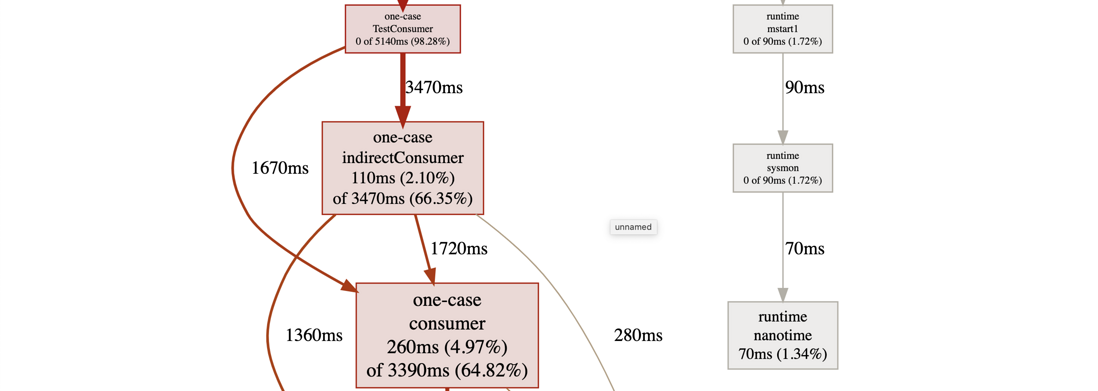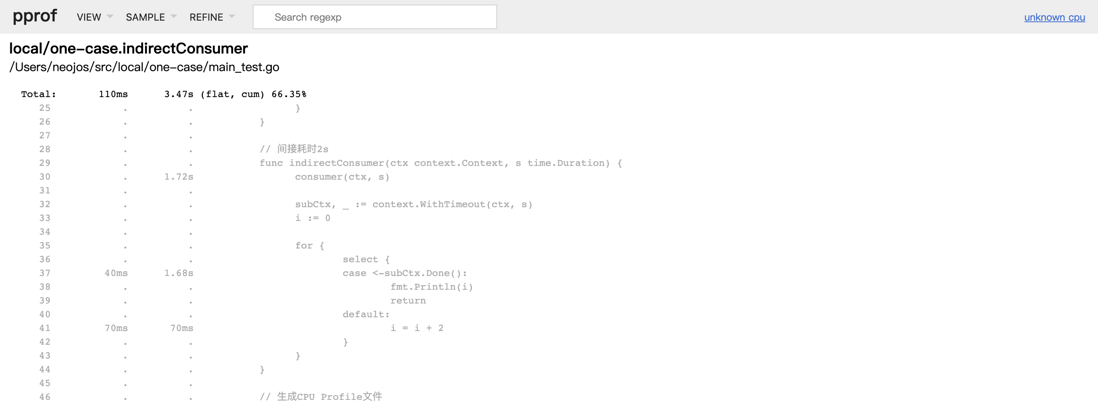测试pprof查看cpu占用
首先,我们声明一个耗时函数。传递一个time.Duration的数据类型,表示函数执行的时间。注意,这里不能使用time.Sleep,它得不到cpu的执行。函数如下:
// 耗时函数
func consumer(ctx context.Context, s time.Duration) {
subCtx, _ := context.WithTimeout(ctx, s)
i := 0
for {
select {
case <-subCtx.Done():
fmt.Println(i)
return
default:
i = i + 2
}
}
}我们再声明一个冗余的函数,这个函数调用consumer,同时Copy一份consumer的逻辑
// 间接耗时4s
func indirectConsumer(ctx context.Context, s time.Duration) {
consumer(ctx, s)
// copy同一份代码
subCtx, _ := context.WithTimeout(ctx, s)
i := 0
for {
select {
case <-subCtx.Done():
fmt.Println(i)
return
default:
i = i + 2
}
}
}最后,我们写一个Test,来生成cpu_profile文件。
// 生成CPU Profile文件
func TestConsumer(t *testing.T) {
pf, err := os.OpenFile("cpu_profile", os.O_RDWR|os.O_CREATE, 0644)
if err != nil {
t.Fatal(err)
}
defer pf.Close()
pprof.StartCPUProfile(pf)
defer pprof.StopCPUProfile()
ctx := context.Background()
// 耗时2s
consumer(ctx, time.Second*2)
// 耗时4s
indirectConsumer(ctx, time.Second*2)
}查看我们生成的pprof文件,这里我们使用web的方式来查看。在命令行执行:
go tool pprof -http=:1888 cpu_profile页面直接跳转到浏览器,并提供了很多菜单选项。我们看一下我机器上Top的情况:
关注一下local/one-case.indirectConsumer和local/one-case.consumer,他们的占比基本是相同的,这也跟我们的预期是相同的。
通过查看Graph我们可以清楚的看到调用的流程。Test内部直接调用了consumer函数,而indirectConsumer也调用了consumer函数。
通过Source我们可以看到具体的代码的耗时占比。它明确的表示了flat和cum占用的时长。从某种意义上来说,这才是所谓的cpu的直接调用和间接调用关系。我们使用indirectConsumer为例:
如果觉得Graph图拉的很长,我们可以选择Flame Graph来查看。我们也展示一下:




**粗体** _斜体_ [链接](http://example.com) `代码` - 列表 > 引用。你还可以使用@来通知其他用户。